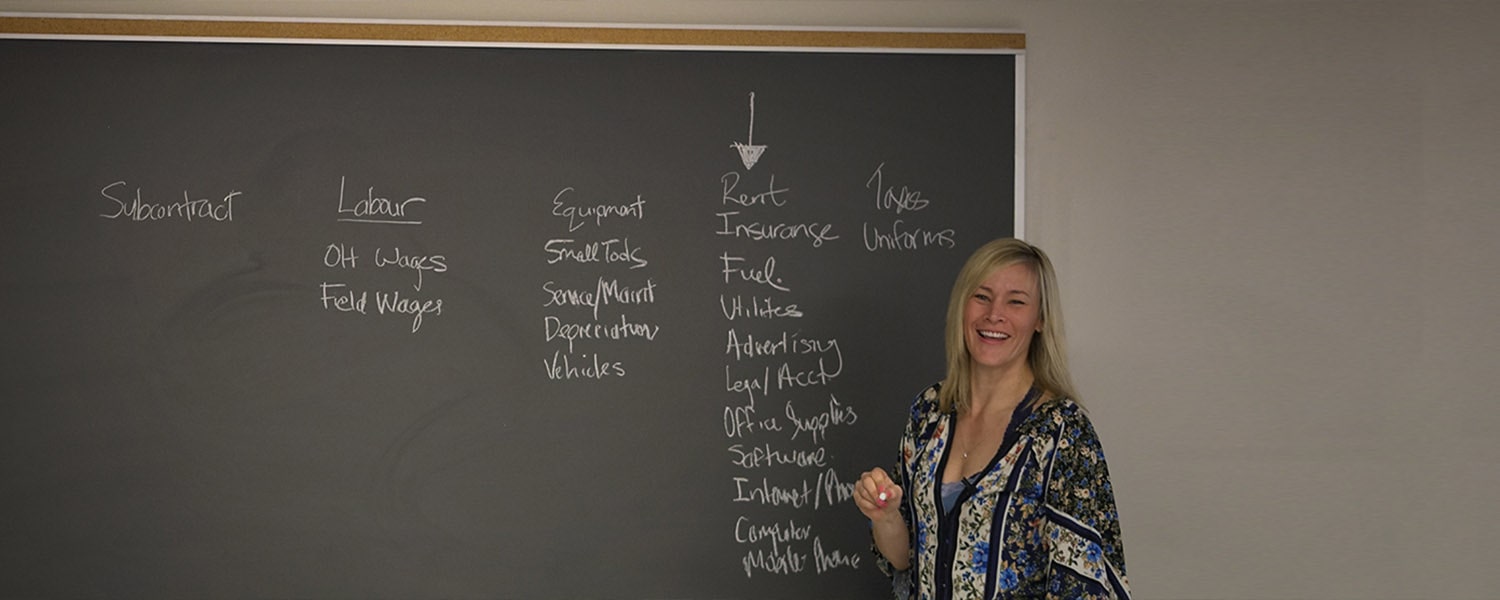The number of women employed in the landscaping industry is slowly on the rise but industry leaders agree that more work needs to be done to attract women to the still male-dominated profession.
Janna Bradley led the growth of one of North America’s top 40 landscaping companies, managing 200+ employees in the delivery of multi-million dollar commercial and residential contracts. She’s also the co-founder of the #1 business management software for landscapers, LMN, which is now used by over 33K landscape professionals. And, she can expertly maneuver a snow plow through some crazy obstacles.
We sat down with Janna to get her story.
How did you start in the landscaping industry?
In 1997, Mark Bradley and I started TBG Landscape (TBG), a small residential landscape design and build company that primarily serviced the Beaches suburb of Toronto. Over the next 8-10 years, we slowly brought on team members including masons, horticulturalists and other experts to keep up with demand. It wasn’t long before we started taking on commercial work including snow removal and landscaping for enterprise-level clients. As a result, we took on more operations staff and larger equipment including a fleet of trucks and aggregate trailers.
Eight years into the business, we had grown to the point where we had 220 employees and were focused on commercial and industrial landscaping, with the residential portion making up just 25% of our business. TBG was growing larger than we ever imagined. Our business was thriving primarily due to our people but we realized quickly that we needed much better systems to run the business effectively, or the business would soon be running us.
How did you manage your landscape business during its growth spurt?
Luckily both Mark and I are business-minded and though TBG began because of our passion for landscaping, we knew that we needed to apply proven business practices if we were to grow, make a profit and most importantly, have a life outside of the business. We started looking for project management software 10 years ago that would meet our needs but there was simply nothing out there. We used Excel spreadsheets for project management, standardized policies and procedures and were constantly working our numbers. But what we really needed was a piece of software that was built to address the unique challenges of landscaping businesses. And that was when the idea for a landscape business management software was born.
When did you realize you had built a solution for landscapers, beyond your business needs?
When we decided we had to build our own custom solution, we were fortunate to have Mike Lysecki on board as the Director of Operations for TBG. With a background in software engineering, Mike was eager to take this project on and lead the development. We started with the basics, building a module for budgeting and estimating. Too many landscapers don’t understand or even know their overhead, which leads to guesstimating landscaping jobs. They put in 80+ hour weeks and they wonder why they’re barely breaking even or worse, losing money.
With the budgeting module, landscapers would finally able to take control of their numbers and ensure they were pricing for profit. Mark and I are very active with the Landscape Ontario industry association. Friendly local competitors were noticing TBG’s growth and asking, ‘so what’s your secret?’. We were happy to educate the industry and share LMN with local landscape businesses through our involvement with Landscape Ontario. It wasn’t long before these early adopters were seeing results and we were driven to commercialize it.
How did you manage both TBG and LMN?
When we knew we had something hot on our hands with LMN, we made the decision to expand development of the platform. Now our goal was to provide a full circle solution, from budgeting and estimating all the way through to scheduling, time tracking, job costing and even LMN integration with QuickBooks.
Mike began hiring a development team, steadily adding modules and resources including a formalized customer service team, training, marketing and sales. For almost eight years, Mark and I juggled both companies. And we were able to do it successfully because LMN was busier in the winter during TBG’s off season and vice versa.
Tell us about the transition from landscaper to software developer
Mark and I had to make a decision. TBG had made a name for itself with $50M in annual sales at its peak and we had an opportunity to expand further. Do we take on more big jobs or pass on the torch? Our passion had shifted to meeting the demand for business education in the industry. So a few years ago, we started to slowly transition out of TBG and into LMN as our main focus.
We had to put in double time for awhile to make the transition successful, hiring key people at LMN to fill in the gaps. Those people are still with us five years later. This year we successfully exited the majority of TBG and have been fully dedicated to LMN.
What was it about your experience with TBG that helped to create a successful software business?
One thing’s for sure: We couldn’t have LMN without the experience of TBG. That’s why we say the platform was ‘built by landscapers, for landscapers’. The entire design was inspired by our own experience knowing a landscaper’s trigger points. For example, the interface had to be designed to work in all kinds of weather. And with a large portion of the workforce speaking English as a second language, the user experience had to be very simple and visual in nature. I don’t believe this software could have been built by someone with no background in landscaping.
We recognize that for the most part, landscapers are tradespeople running businesses. They are talented designers who love what they do but lack the business expertise. Part of our mandate has been to supplement their business knowledge as much as we can. The launch of the LMN Academy has helped thousands of landscapers across North America successfully adopt a technology that allows them to finally take control of their businesses. Once they commit to change, they learn how to price work for profit, use one system and increase efficiencies across their entire business.
What’s been one of the most rewarding experiences in your LMN journey so far?
It has to be the Aha! moments business owners and teams have with the software. These are the moments where they clearly see the need to change or the outcome of the change.
I was teaching a workshop once and a guy put his hand up and said, “I have to fire seven of my clients”. I said, “You’re not charging enough are you?” He was pretty gutted at his realization. “There’s no way that I can run these jobs with these clients at this price.” We had just finished putting his budget together and took a look at the numbers together. That segment of housing was indeed losing money. “You have four choices here. You can decrease the labor on the crew, increase the prices to the client or find more houses on that street so you’re able to do more in the same amount of time. Or, drop them.”
Because he was now operating his business from a budget, not only could he see exactly where has losing money but for the first time since he started his company, he was able to make a decision based on facts instead of hunches. Now he was on the path to building a successful landscape business.
Can you describe how the industry has evolved in recent years?
The industry was 15 years behind everyone else where technology was concerned and many landscape companies are still paper-based with old-fashioned punch clocks. But now that businesses are being passed down from parents to children, the next generation is more open to change and eager to embrace technology that will help them build better businesses.
In the last few years, we’ve been seeing a notable shift from a ‘why do we need that?’ to a ‘we need that’ mentality. Landscapers now realize that in order to run a successful business, they need to invest the time learning new systems and adopting new practices.
What’s the biggest change that needs to happen in the landscape industry?
Landscapers are wearing too many hats and that needs to change if they’re going to have quality of life. If I think back to my experience running TBG before LMN, I’m amazed at how I managed a typical week. I’d meet with clients as the designer and then go back the next day and price as the estimator. I’d spend 3-4 hours a day bookkeeping. If it snowed, I’d be out plowing. And when maintenance work was in full swing, I’d join the crews pulling weeds.
The majority of landscape business owners are overworked and underpaid. They’re putting in 80 hours a week and some of them are barely breaking even. If we can show them how to work smarter, not harder, we’re succeeding. LMN is so much more than just software. It teaches landscapers how to run a better business and pass off some of those hats by virtue of better understanding their business. When implemented, the software will show them how making changes like hiring more people or purchasing equipment can actually increase their revenue and ultimately, give them their lives back. They can have time for their daughter’s soccer game or even that long-promised family vacation.
Can you comment on what the industry is doing to attract women?
Having been in the industry for 20 years, it’s wonderful to see an increase each year in the number of women getting into the field. It’s partly thanks to the work of industry associations like Landscape Ontario who are prioritizing the recruitment of women by sharing their stories, highlighting their contributions and establishing relationships with local college programs. They actually launched the Women in Landscaping organization to provide support, education and networking opportunities.
I’m proud of the work we’ve done here at LMN to champion women in landscaping. In fact, our team is over 50% women. And just last month, at the Landscape Mastermind Summit, we recognized Rachel Hoss with the “Women in Landscape Leadership” award.
You’re passionate about giving back to the community. Tell us about your contributions.
After years of donating to local charities, we decided to start a not-for-profit that aligned with our love of being active in the outdoors. Eight years ago, we founded the Durham Shredders, a mountain biking club in Durham, Ontario with a mandate to get kids on bikes and teach them valuable technical skills and personal development like team building, an appreciation for nature and confidence.
The Shredders offer learn to ride and competitive racing programs for kids ages 5-17 as well as adults. We’re lucky to have some highly qualified, certified instructors teaching and motivating our members. We’ve also set up a program to fund participation in the club for underprivileged children in the area and have partnered with corporate sponsors to offset competition fees and travel costs for participants.
Since The Shredders started, we’ve had more than 1200 families participate in the program. And we’re proud to say that our under 23 age category competes internationally. The Durham Shredders also has an initiative to get girls involved in sports through the program, encouraging them active and outdoors well into their late teens. We’re so proud to help build the next generation of leaders.
LMN is dedicated to shining the spotlight on female role models in the landscape industry, those in the office and on site. By sharing their stories, we hope to encourage more women to consider landscaping as a promising career path. Watch Janna Bradley’s Facebook interview with landscape industry consultant Jackie Hart of Consulting by Hart.




